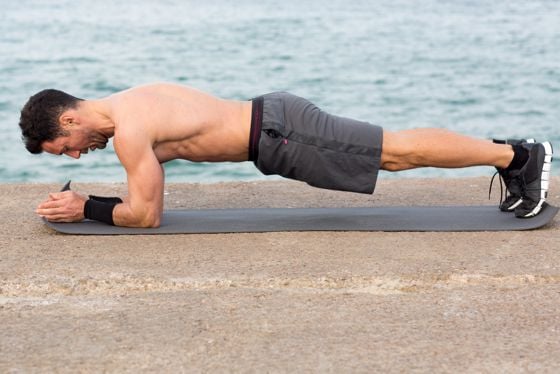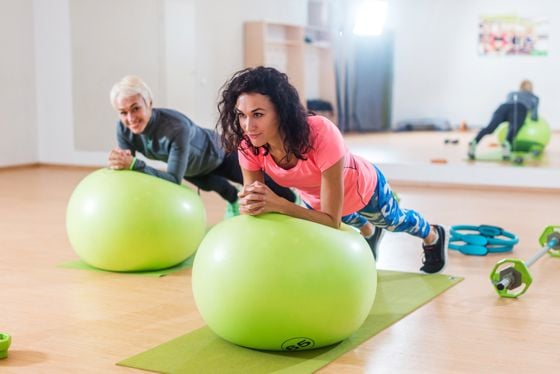Core Muscle Training: 7 great exercises to do at home
Effective exercises for a strong core

It doesn't have to be a six-pack. Because even without a visual effect, well-trained abdominal muscles have many positive effects. But what exactly? What does effective abdominal muscle training look like and what effort is required? We show you the seven best abdominal exercises and everything you need to know about training for a strong core.
Contents:
- Core Strength Training: The Basics
- The benefits of abdominal muscle training: it doesn't have to be a six-pack
- Abdominal muscle training for beginners - 3 effective exercises
- Abdominal muscle training for advanced users - 4 exercises for a strong core
- You should avoid these mistakes when training your abdominal muscles
- The most important questions about abdominal muscle training at a glance
- All set: get started with effective abdominal muscle training
Core muscle training: the basics
The big advantage of abdominal muscle training is that you don't need expensive equipment, nor do you have to register at the nearest gym. Abdominal training also works at home, in the garden or on vacation. Basically anywhere where you have enough space to roll out your mat.
But not all abdominal training is the same. After all, the core combines various muscle groups that all perform different tasks and can be trained in different ways. There are three main areas: the front straight, the lateral inner and outer and the rear deep abdominal muscles. In order to train all areas properly, you should make your abdominal training as varied as possible.
The benefits of abdominal muscle training: it doesn't have to be a six-pack
Even if you train your abdominal muscles as intensively as possible, you have no guarantee of a six-pack. This is because how visible your abdominal muscles are also depends on your body fat percentage. The more fat you have, the less visible your muscles will be. Accordingly, in addition to abdominal training, you need a balanced diet for a six-pack.
-
Visible or not, in the end a well-trained abdominal musculature brings many advantages:
- It improves posture, prevents back pain and prevents a hollow back and pelvic tilt.
- Strong abdominal muscles allow excellent power transmission from the center of the body, which you can also use for other sports.
To enable you to train to the full, we therefore present effective exercises that you can use to train your abdominal muscles at almost any time.
Abdominal muscle training for beginners - 3 effective exercises
You already know that you don't need expensive, space-consuming equipment. All you need is a mat or another soft surface. Plus, of course, the right sports outfit from our owayo shop. Below we present three exercises that are ideal for beginners:
1. Planking
Planking is one of the most effective exercises for the entire core. Especially as you can do it spontaneously at any time. As you stretch out, support yourself on your forearms at the front - with your elbows resting at shoulder height - and on your toes at the back. This creates a straight plank. It is important that your back does not sag or round.
Planking derives its efficiency from the variety of muscle groups that the exercise targets. Although the focus is on the core and abdominal muscles, the exercise also involves the back, shoulders, chest, arms, buttocks and thighs. As a beginner, start by training your abdominal muscles with 30 seconds of planking. You can then slowly increase the time. It is important that you always perform the exercise correctly. This is the only way to achieve the desired effect and avoid injuries.

2. Side Plank
If you want to train your lateral abdominal muscles, you can try the side plank. Here too, the weight is placed on the forearms below the shoulders. But only on one of them. Your foot on the same side, which also rests on the side, provides balance. In this way, you train one side of your abdominal muscles in a concentrated manner. It is therefore important to switch to the other side in order to maintain your balance.
You can make your abdominal training at home more intensive by also lifting and lowering your upper leg. Hip dips are another option. This involves slowly lowering your hips towards the floor and then raising them again. Again, the following applies: correct execution of the exercise remains the maxim.

3. Bird Dog
An exercise that is particularly suitable for beginners to abdominal muscle training.
How to perform the exercise:
- Kneel on your mat or soft surface.
- Your hands are placed shoulder-width apart at shoulder level.
- Now stretch one leg, for example your left leg, straight back.
- Now shift the weight to your left hand and go to your fingertips with your right hand.
- If you can keep your balance, stretch your right arm forward.
- After holding briefly, bring your right elbow and left knee together underneath your upper body and then extend both again.
As a beginner, repeat this process around ten times. Then change sides. Right leg meets left arm. The more stable you feel, the more repetitions you can do.
It is important to perform the abdominal exercise accurately. Keep your back straight and avoid a hollow back. In addition, the arms go forward without much shoulder movement, while you can keep your balance at all times.
In this video you can see how to do the Bird Dog correctly:
Abdominal exercises for advanced users - 4 exercises for a strong core
If you are more experienced and feel confident with the three exercises mentioned above, then try the following abdominal exercises.
1. Swiss-Ball-Plank
The plank in its basic form is a static exercise. You hold the position on a firm surface. Once you have mastered the basics, you can challenge yourself even more: Place your forearms on an exercise ball during the plank.
Now the ground moves. Your body has to compensate for this movement and the core muscles have to work even harder. This permanent adaptation to a new position places additional demands on the muscles and therefore helps to train your abdominal muscles even more intensively. You can go one step further by actively moving the ball back and forth with your forearms during the exercise.

2. Bear Crawl
For the bear crawl, start by kneeling on the floor in the same position as for the bird-dog crunches. Leaning on your toes, lift your knees slightly so that they hover a few centimetres above the floor. Tighten your abdominal muscles.
If you still feel uncertain, hold this position. In this case, we speak of a bear hold. By staying in this exercise, you ensure that you are really stable and that you are performing the movement correctly and effectively. As soon as you are ready, move forward by alternately pushing the opposite hands and legs forward. So: left hand, right leg, right hand, left leg. You are therefore "crawling" across the floor.
3. Bicycle Crunch
Traditional sit-ups are a great way to train your abdominal muscles. At the same time, you want and should add variety to your workout. Bicycle crunches offer you this opportunity - including an additional challenge. As with normal sit-ups, you start by lying on your back with your hands clasped behind your head. However, raise your legs and bend your knees so that your shins are parallel to the floor.
Now start to imitate the pedaling movement on the bike with your legs. At the same time, lift your shoulders off the ground and move your elbows alternately towards the opposite knee. Aim for around ten repetitions at the start and make sure that you do not perform the movements jerkily.
4. Farmers Walk
The basic concept of the Farmers Walk is based on a route that you cover with heavy weights in both hands. You need your arms, of course, but not only your arms. The torso and back must stabilize the body, making the Farmers Walk perfect for abdominal muscle training.
It is important that you maintain a stable torso and keep your back straight. Especially when lifting the weights. The shoulder blades help you by pushing them backwards. You also lift the weights from your knees. Then move forward in small, flowing steps, making sure that one foot is always in contact with the floor. Crucial: a tense, stable upper body.
Increase slowly and start with light weights. If you don't have any weights, you can also fill bags or rucksacks with books for abdominal training at home. Make sure you distribute the weight evenly.

You should avoid these mistakes when training your abdominal muscles
Performing abdominal exercises correctly is important in two ways. On the one hand, this is the only way to achieve the desired effect. On the other hand you reduce injuries and incorrect strain by performing the exercises correctly. Make sure you pay attention to this,
- Do not perform abdominal exercises with momentum and do not pull your upper body upwards, for example
- not to concentrate exclusively on the abdominal muscles. As the abdominals, core, hips and torso form a unit that must work together and harmonize, train all muscle groups together.
- do not repeat the same exercise every time you work out. Only through new stimuli, for example resistance bands, will your abdominal muscles grow;
- always take breaks, which are just as important for muscle growth as intensive abdominal muscle training.
- eating a balanced diet if you are aiming for a six-pack.
The most important questions about abdominal muscle training at a glance
The perfect amount of exercise is one of the most important criteria for successful abdominal muscle training. But how much is just right and when is it too much? Why does the six-pack fail to materialize, which abdominal muscle exercise is the best and what is the best way for women to train? Read the answers to the most burning questions about abdominal muscle training here.
How often should I train my abdominal muscles?
Scheduling an abdominal muscle workout every day can be counterproductive. Especially with sore muscles. It serves as an indication that your body needs rest - and the muscles in turn need regeneration phases in order to grow. Therefore, start by training your abdominal muscles two to three times a week and listen to your body. Training into the pain is not helpful. In our magazine you will find how to beat sore muscles.
Can I train my abdominal muscles every day?
Daily training does not increase the likelihood of a six-pack. On the contrary. As you deprive your muscles of their rest breaks, they grow less quickly. It is therefore better to dose your abdominal muscle training and not start a new workout every day.
Why can't I get a six-pack despite training?
The lack of a six-pack with constant training performance can have various reasons. Overtraining, for example. You are challenging your abdominal muscles too intensively and thus depriving them of the opportunity to grow during rest breaks.
Another reason can be one-sided training. If you focus solely on sit-ups, for example, the muscles only receive this one stimulus. For constant growth, however, they need different stimuli. Therefore, make your abdominal muscle training varied. Also remember to train your lower, lateral or oblique abdominal muscles with appropriate exercises.
Nutrition also plays a key role. After all, a six-pack only becomes visible at a certain body fat percentage (the exact value varies from person to person). A healthy diet is essential to get a six pack.
Which exercises do I use to train my oblique abdominal muscles?
Alongside the sit-up, the crunch is one of the most famous abdominal exercises. Instead of sitting up completely, raise your upper body just enough to lift your shoulders off the mat. The lower back remains in contact with the floor. Use this concept for the oblique abdominal muscles: Bring your left elbow towards your right knee during a crunch - and vice versa. Side planks or Russian twists are also suitable.
What is the best abdominal exercise?
There is no one perfect exercise for your abdominal muscle training. Ultimately, you have to find your own favorite. However, planking is considered one of the most effective abdominal exercises because it targets a variety of different muscle groups.
Is there special abdominal muscle training for women?
Basically, women can do most of the same exercises as men. Sit-ups and planks, for example, are just as suitable for abdominal muscle training for women as they are for men. The same applies to side planks, bicycle crunches and bird dog crunches. Toe touches, where you lie on your back, stretch your legs vertically upwards and then touch your toes with your fingers, are another option. You adopt a similar basic position for leg lifts. Here you lie flat on the floor, raise your outstretched legs up to 90 degrees and bring them back down towards the floor before lifting them again before they reach the ground.
All set: get started with effective abdominal muscle training
It pays to train your abdominal muscles. That much has long been clear. Especially as you now have the right exercises with instructions for your workout. The basic requirements for successful abdominal muscle training are now in place. The only thing missing is the right outfit. You can find this in the owayo-Shop. Create your own design for a top or pants in our 3D-Designer
Do you need more tips and exercises for your strength and muscle training? In our magazine you will find detailed information and exercises to get fit.
Image Credits: Title Image: Michaela Begsteiger/stock.adobe.com; Image 2: Adam Gregor/stock.adobe.com; Image 3: deagreez/stock.adobe.com; Image 4: undrey/stock.adobe.com; Image 5: JakobLund/stock.adobe.com

